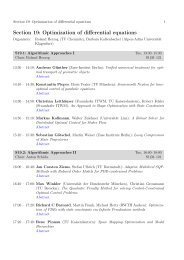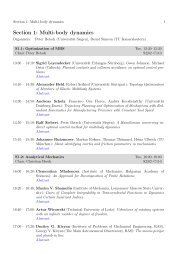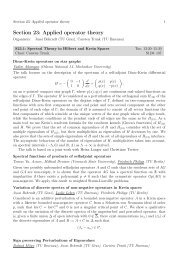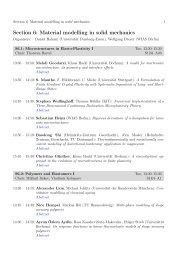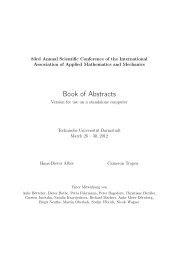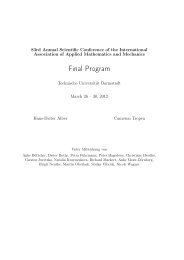Section 6: Material modelling in solid mechanics - GAMM 2012
Section 6: Material modelling in solid mechanics - GAMM 2012
Section 6: Material modelling in solid mechanics - GAMM 2012
Create successful ePaper yourself
Turn your PDF publications into a flip-book with our unique Google optimized e-Paper software.
<strong>Section</strong> 6: <strong>Material</strong> <strong>modell<strong>in</strong>g</strong> <strong>in</strong> <strong>solid</strong> <strong>mechanics</strong> 9<br />
<strong>in</strong> a relatively simple form and are able to describe the asymptotic behavior of the <strong>in</strong>verse Langev<strong>in</strong><br />
function <strong>in</strong> the vic<strong>in</strong>ity of the maximum cha<strong>in</strong> extensibility. Far away from the asymptotic<br />
area the approximation error can be, however, relatively large. In the present contribution we<br />
compare various Padé approximants with the Taylor power series representation of the <strong>in</strong>verse<br />
Langev<strong>in</strong> function. To this end, a simple recursive procedure calculat<strong>in</strong>g power series coefficients<br />
of the <strong>in</strong>verse function is proposed. The procedure can be applied to any function which can be<br />
expanded <strong>in</strong>to Taylor series. With<strong>in</strong> the convergence radius the result<strong>in</strong>g series of the <strong>in</strong>versed<br />
Langev<strong>in</strong> function demonstrates better agreement with the analytical solution than the Padé approximations.<br />
Phenomenological model<strong>in</strong>g of a polymeric composite<br />
Sebastian Borsch, Albrecht Bertram (Universität Magdeburg)<br />
A composite material consist<strong>in</strong>g of a polymeric matrix material and metallic filler particles is<br />
modeled <strong>in</strong> a phenomenological way. The isotropic viscoplastic constitutive model is formulated<br />
with<strong>in</strong> the theory of f<strong>in</strong>ite deformations. The flow rule is a superposition of two terms. This<br />
approach enables us to simulate the strong backflow behavior dur<strong>in</strong>g unload<strong>in</strong>g, which can be<br />
observed <strong>in</strong> various polymeric materials. A quasi-static f<strong>in</strong>ite-element simulation has been performed<br />
to compare the model with cyclic tension tests as well as a relaxation test.<br />
Modell<strong>in</strong>g of nano<strong>in</strong>dentation of polymers with effects of surface roughness and parameters<br />
identification<br />
Zhaoyu Chen, Stefan Diebels (Universität des Saarlandes)<br />
S<strong>in</strong>ce the nano<strong>in</strong>dentation test<strong>in</strong>g technique can measure the properties of extremely small volumes<br />
with sub-m and sub-N resolution from the cont<strong>in</strong>uously sensed force-displacement curves,<br />
it also became one of the primary test<strong>in</strong>g techniques for polymeric materials and biological tissues.<br />
The analysis of <strong>in</strong>dividual <strong>in</strong>dentation tests us<strong>in</strong>g the conventionally applied Oliver & Pharr<br />
method has limitations to capture the hyperelastic and rate-dependent properties of polymers.<br />
Therefore, an <strong>in</strong>verse method with respect to the experimental test<strong>in</strong>g, based on f<strong>in</strong>ite element<br />
simulation and numerical optimisation has been used and evolved. However, nano<strong>in</strong>dentation is<br />
composed of various error contributions, e. g. friction, adhesion, surface roughness and <strong>in</strong>dentation<br />
process associated factors. These contributions form<strong>in</strong>g the systematic errors between the<br />
numerical model and the experiments will often lead to large errors <strong>in</strong> the parameters identification.<br />
Therefore, basic <strong>in</strong>vestigations and quantification of these <strong>in</strong>fluences are <strong>in</strong>dispensable to<br />
characterise the materials accurately from nano<strong>in</strong>dentation based on the <strong>in</strong>verse method.<br />
In the present contribution, the characterisation of polymers through nano<strong>in</strong>dentation with effects<br />
of the surface roughness based on <strong>in</strong>verse method will be <strong>in</strong>vestigated numerically. The boundary<br />
value problems of nano<strong>in</strong>dentation of polymers are modelled with the FE code ABAQUS R○ .<br />
In contrast to the traditional <strong>in</strong>verse method, virtual experimental data calculated by numerical<br />
simulations with chosen parameters replace the real experimental measurements. Such a procedure<br />
is called parameter re-identification. In this sense, the f<strong>in</strong>ite element code ABAQUS R○ is used as<br />
our virtual laboratory. The model parameters are identified us<strong>in</strong>g an evolution strategy based on<br />
the concept of numerical optimisation. The surface roughness effects are <strong>in</strong>vestigated numerically<br />
based on the approach utiliz<strong>in</strong>g the phenomenological concepts. The surface roughness is chosen<br />
to have a simple representation consider<strong>in</strong>g only one-level of roughness profile described by a<br />
s<strong>in</strong>e function. The <strong>in</strong>fluence of the surface roughness is quantified associated to the s<strong>in</strong>e curve<br />
parameters as well as to the <strong>in</strong>dentation parameters. Moreover, the real surface topography is



